What is the best carpet for pets? Flooring for furry friends
After the best carpet for pets? Owners of four-legged friends need something a little extra from their flooring if they want it to stay looking good and performing well

The best carpet for pets needs to be up to the job of withstanding claws, fur, muddy paws and a whole host of other animal-related issues.
Certain types of carpet are better suited to households with pets than others so if you want something soft and comfortable underfoot, but are keen to avoid anything too high maintenance when it comes to care and cleaning, it is wise to select a product that is designed to withstand whatever your pet throws at it.
Here, we explain the best carpet options for those sharing their home with pets, including the wisest material choices as well as the specific styles that offer the best durability and stain resistance.
Which is the best carpet for pets?
While the majority of people after the best floor for dogs tend to assume that only washable, hard flooring, such as tile or laminate, is suitable, there is no need to rule out carpet completely.
What you want from your carpet is something that is hardwearing, easy-to-clean and low-maintenance. Thankfully, there are carpets available which tick all these boxes, meaning there is no need to discount a soft flooring.
Material, pile and colour should be your main concerns when choosing a carpet that won't be ruined by your pet.
As mentioned before, certain materials and designs are far better suited to homes populated by pets than others and here we explain the kinds of carpets you want to focus your search on if something pet-friendly is important to you.
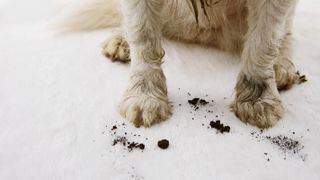
Is wool carpet suitable for pets?
Those keen to stick to natural materials in their home design will probably be keen to opt for a wool carpet and there is no need to feel as though this will cause problems just because you have pets. In fact, wool carpets have many benefits for pet owners.
“The protective, waxy coating on the fibres makes wool products resistant to staining,” explains Lisa Conway, residential marketing manager at Brintons. “A wool carpet will also pick up less dust as the material is naturally anti-static.”
"Carpets made from wool are naturally hardwearing because of the strength and durability of the material," says Sarah Jenkinson Kingsmead product manager. "The fibres of wool also repel dirt and stains — the ideal foundation to endure busy life."
Of course it is not just that those with animals want to protect their floor from their pets — they will no doubt be keen that their flooring benefits their pet's lives in whatever way it can.
Wool is a non-allergenic fibre that inhibits the growth of bacteria and dust mites and doesn't give off harmful emissions, making it a healthy choice for elderly pets as well as those with compromised immune systems. In addition, it has the ability to absorb air contaminants, acting as a natural air filter.
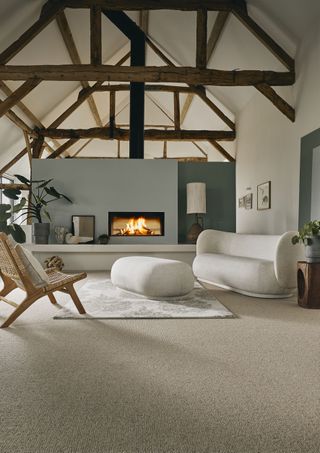
Are synthetic carpets pet-friendly?
Synthetic carpets or those made from a wool blend are another great option for those with pets — plus they are a great choice for anyone keen to minimise carpet costs.
“Some manmade fibres like nylon 6.6 offer the same benefits as wool carpets but with better cleaning and maintenance properties,” says Gregory Powley-Lynch, operations director at Elements London.
Polypropylene is the most popular of all the synthetic carpet materials — and for good reason. Not only is it an affordable option, but polypropylene is also very pet-friendly as it is so easy to clean — many products made from this fibre can even be cleaned with bleach-mix cleaning solutions.
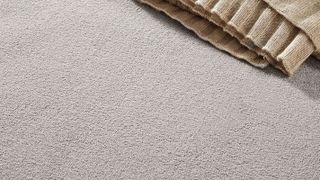
Are natural carpets suitable for pet owners?
Natural flooring is a really popular alternative to synthetic carpets and there are many different materials to choose from — although not all are suitable for those with pets.
Coir, in particular, is a great choice. While it does not feel as soft and cosy underfoot as some other materials, it is extremely hardwearing, comes in a medium brown shade that is perfect at hiding stains and is great at absorbing sound.
Jute and seagrass tend not to be as hardwearing and so are not always recommended for those with pets, plus jute is slightly more absorbent — not ideal for all that post-wet walk shaking.
Finally, sisal offers both pros and cons for animal lovers.
"Super hardwearing, sisal is available in an array of weaves and natural shades," explains Lorna Haigh of Alternative Flooring. "As sisal is expertly woven in different strand shades it often has a darker fleck in the carpet. Dark flecks hide a multitude of sins."
On the downside, sisal can be tricky to clean should it get stained. "Sisal is extremely unforgiving for pets as it is not easy to clean," says Gemma Holsgrove, associate director at interior design specialists Sims Hilditch . "You can take steps to protect it, but this isn't a permanent solution."
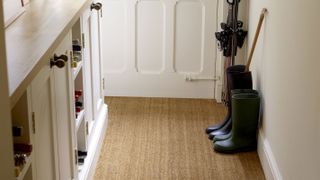
Which carpet piles are most hardwearing?
The type of carpet pile you opt for will actually have just as much of an effect on how capable it will be of handling all that your pets can throw at is as the material it is made from.
“If you have a cat or another pet with sharp claws, your new carpet has the capacity to become the ultimate playground for them. It will more than likely end in tears — for you, not the pet!” says Charles Barraclough, operations director at Wools of Cumbria Carpets. “Cut pile carpets are absolutely fine though. What’s more, they will hold onto moulted fur until you’re ready to vacuum, rather than harder surfaces which let it float around the edges of the room.”
"A loop pile wool carpet can be problematic as its fabric is easily snagged by claws," says Gemma Holsgrove. "A more formal cut pile carpet design is a little difficult to clean when subjected to dirt and damp."
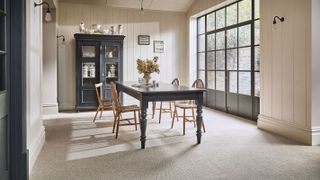
Get the Homebuilding & Renovating Newsletter
Bring your dream home to life with expert advice, how to guides and design inspiration. Sign up for our newsletter and get two free tickets to a Homebuilding & Renovating Show near you.
Natasha was Homebuilding & Renovating’s Associate Content Editor and was a member of the Homebuilding team for over two decades. In her role on Homebuilding & Renovating she imparted her knowledge on a wide range of renovation topics, from window condensation to renovating bathrooms, to removing walls and adding an extension. She continues to write for Homebuilding on these topics, and more. An experienced journalist and renovation expert, she also writes for a number of other homes titles, including Homes & Gardens and Ideal Homes. Over the years Natasha has renovated and carried out a side extension to a Victorian terrace. She is currently living in the rural Edwardian cottage she renovated and extended on a largely DIY basis, living on site for the duration of the project.
